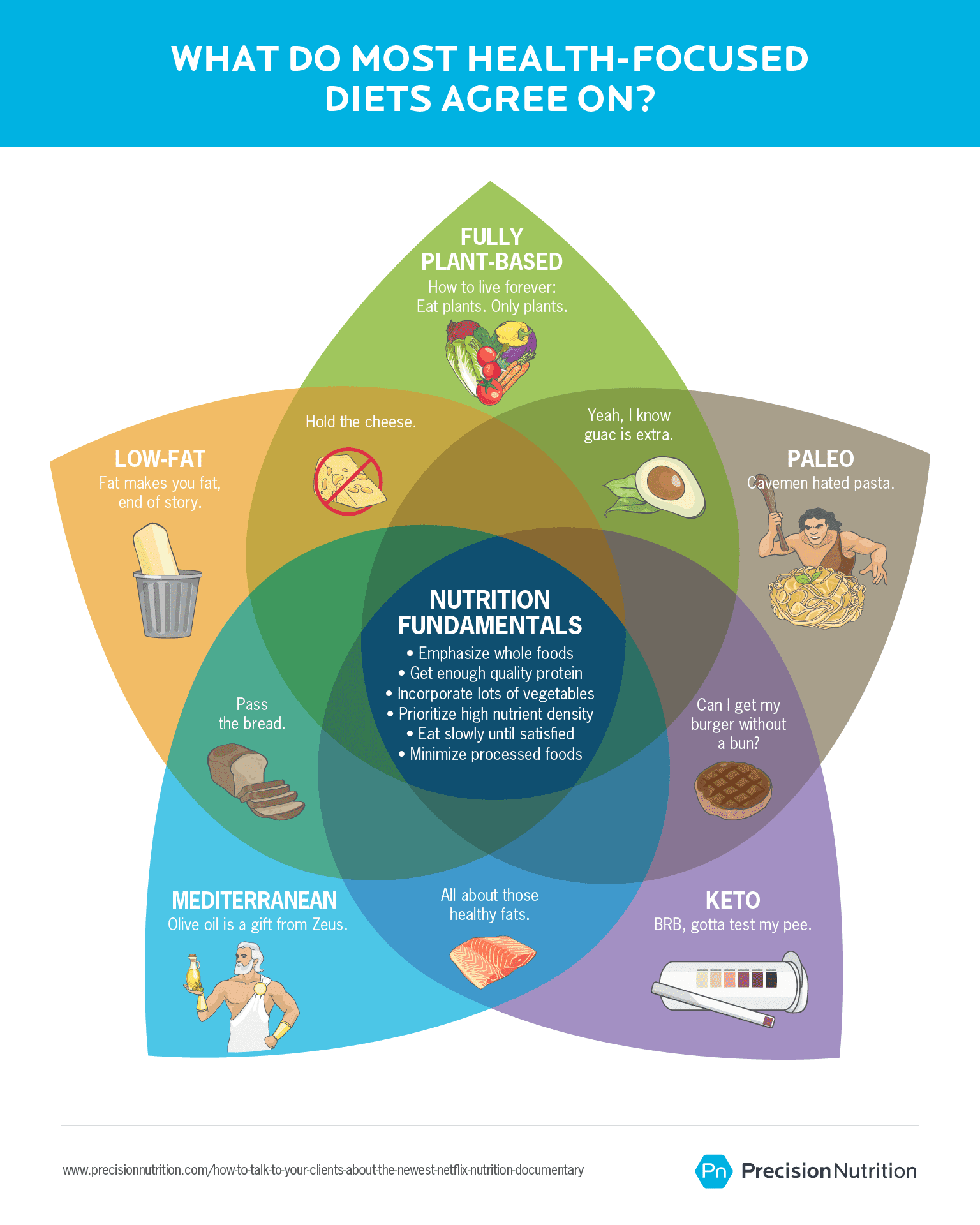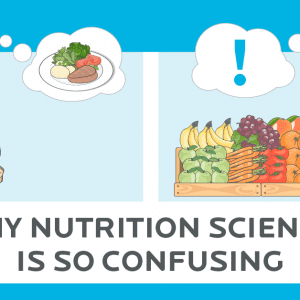When it comes to nutrition, there’s plenty we don’t know.
Although it may be hard to accept, the jury’s still out on red meat. On eggs. On low carb versus low fat. On Paleo versus fully plant-based.
In fact, there’s very little we can say with absolute certainty.
Science hasn’t identified one best diet or eating approach.
Because of that, you can be sure no documentary filmmaker has. No matter how compelling or convincing the movie.
(This includes filmmakers you agree with, by the way.)
So what do you do when a client—or a friend or family member—watches a trending nutrition documentary and becomes captivated with:
- nutrition advice that contradicts what you’ve been telling them?
- questionable eating methods you believe will set them back?
- an extreme diet you’re pretty darn sure will fail?
First, take a breath. (Or two.)
Next, understand that, in most cases, you can’t “prove” anyone wrong.
More importantly: You shouldn’t even try.
There’s a much healthier and more effective approach for your clients, your business, and your sanity…
Aim to be helpful, not right.
This mindset lightens the tone of your conversations, fosters trust and appreciation, and allows you to ultimately have greater influence. (It’ll make you more likable on social media, too.)
Admittedly, this doesn’t always feel second nature. But with practice, it can become that way.
The payoff is huge: Instead of dreading the next big nutrition documentary, you can use it to build a stronger and more productive relationship with anyone who seeks your help.
This article will show you how.
Why you don’t need to be right.
Before we get to helping clients, let’s address a big hurdle: Our deep need to be right.
The reality is this: Most nutrition debates won’t be resolved anytime soon. Probably not even in our lifetimes.
(To better understand why, read: Why nutrition science is so confusing.)
You might even think of it this way:
Scientific progress is more about being progressively less wrong than suddenly understanding some ultimate truth.
So in many ways, we’ll never really know if we’re “right.”
Accepting this can help you become a more thoughtful, open coach (and human being).
Plus, trying to prove to your client that you’re “right” interferes with your ability to develop a strong coaching relationship. It might even hinder your chances of helping them.
Because unless you ask questions to find out what resonates with your client about “Diet Fad X,” you’ll never understand what need they’re trying to meet with that approach.
That’s a missed opportunity to leverage what matters to your client to create real change. (More on why the best coaches shut up and listen in a bit.)
There’s one downside, however, with accepting that there’s often no “right” answer in nutrition: It can be unsettling.
For some coaches, nutritional uncertainty raises foundation-shaking questions, such as:
- How can you feel comfortable giving guidance based on incomplete information?
- How can you avoid a crisis of confidence when you encounter a new, exciting nutritional theory—that goes against everything you were taught?
- How can you tell the difference between evolving your coaching philosophy and getting caught up in a fad?
To help answer these questions, Craig Weller, Precision Nutrition Master Coach and resident exercise specialist, points to a fascinating research paper titled, The End of History Illusion. It provides a useful analogy for coming to terms with nutritional uncertainty.
The scientists’ findings: If you ask someone how much they’ve changed as a person in the past and how much they believe they’ll change in the future, they’ll virtually always say that most of their change is already behind them. This is true whether they’re 18 or 68.
“As humans, we tend to believe we’re already the person we’ll be for the rest of our lives, but that’s not how it actually works,” says Weller. “It’s the same in science and nutrition.”
“If we look back 150, 20, or even just 10 years ago, there were things people strongly believed to be true about nutrition that eventually were disproven or shown to be irrelevant.”
This isn’t to suggest you should ignore the current thinking and research on nutrition. It’s to emphasize uncertainty has always existed, not only in nutrition and science but in almost every aspect of life.
Even if we feel certain about something today—the love of our life, that awesome new job, a SpongeBob tattoo—we might feel differently in a decade.
So what can you do?
Focus on what you know with the highest degree of confidence in any given moment.
(We’ll cover the specifics in the next section.)
Then explore new ideas and alternative methods as experiments. Gather data, and choose the best path forward based on the outcome.
The benefit: You don’t need to be right before you start. You can use nutrition experiments to better understand what works for each individual.
This is truly customized nutrition coaching, and it keeps you open (and chill) to any approach your client wants to try.
(Want the hottest nutrition, health, and coaching strategies delivered straight to your inbox? Sign up for our FREE weekly newsletter, The Smartest Coach in the Room.)
What we (mostly) know for sure about nutrition science
If you think nutritional uncertainty causes problems for you, imagine what it’s like for clients.
“There’s a lot of contradictory information out there, causing tribalism and discord where there need not be any,” says Brian St. Pierre, MS, RD, CSCS, Precision Nutrition’s director of nutrition.
“These passionate and often conflicting messages only end up confusing people and discouraging them from getting started in the first place, since it appears that ‘no one knows what’s right anyway.’”
This is where you can help provide clarity and focus.
How? By emphasizing the importance—and effectiveness—of just a handful of very basic principles.
Despite all of the seemingly-conflicting information, there are several foundational elements that virtually everyone agrees with, says St. Pierre:
- Eat more minimally-processed whole foods and fewer highly-processed foods
- More vegetables are better than fewer vegetables
- Eating enough protein is crucial for health, performance, and body composition
- In the long-term, learning to manage your food intake based on your body’s hunger and fullness cues works better than weighing and measuring everything you eat. (Read more on this topic.)
“Make these four principles the foundation of your dietary recommendations,” says St. Pierre.

Think of the middle of the Venn diagram as the fundamentals of nutrition. These keep clients on track and help you feel confident in your advice.
And those outside sections? They aren’t life or death. Whether your client wants to eat like a caveman, give up meat forever, or make olive oil their life force is a matter of personal preference.
Ultimately, your client is the boss of how they eat.
So if they want to try something new as a result of a nutrition documentary, that’s their call.
Your role: Help them do it better.
Here’s how to do just that.
Your 5-step guide for helping clients (even if you think they might be wrong)
Step 1: Give positive feedback.
If a client is excited by a nutrition documentary, don’t tell them it’s wrong. This can feel dismissive, and it minimizes their thoughts and feelings.
Instead, do as David Burns, MD, a pioneer in the field of cognitive behavioral therapy and creator of the T.E.A.M. counseling method says: “Find the truth in what they’re saying.”
One way to do that is through positive feedback, says Precision Nutrition Master Coach Kate Solovieva, MA. “This allows your client an opportunity to engage in ‘self-enhancement,’ a basic type of motivation that’s associated with both increased self-esteem and sense of control.”
These are assets when you’re helping someone improve their nutrition.
Welcome their questions, opinions, and concerns in a way that says, “What you think matters, and I want to talk about anything important to you.”
For example:
- If they ask a question, you might lead with: “I’m so glad you asked!”
- If they’re concerned about how their current habits might impact their well-being: “It’s awesome you care so much about your health!”
- If they’ve taken a keen interest in a particular documentary or nutrition topic: “I’m impressed you’re looking into nutrition in your spare time. That’s pretty cool!”
Step 2: Express curiosity.
“See if you can have a discussion about the film without explicitly stating your beliefs about it,” advises Solovieva.
So, ask lots of questions and be a good listener. Or as Solovieva says: “Practice good coaching.”
Your charge: Find out what they learned that was so intriguing (or unsettling) to them… and why.
Here are some questions that could help you learn more, and potentially help you decide (together) what to do next:
If they’re resisting what you’ve been telling them because the nutrition documentary conflicts…
- Ask this: “Can you tell me a bit more about that? Which points stood out to you? What seems like a better approach to you, and why?”
If they’re worried their current plan is taking them down the wrong path…
- Ask this: “I can understand why you’re concerned. I’m wondering if you can tell me more about how the documentary conflicts with the work we’re doing together? Is there anything specific you’d like to do differently?”
If they’re interested in implementing changes based on the nutrition documentary…
- Ask this: “What about making this change feels appealing to you? How do you think this change will benefit you? Is there anything about it that you think will be challenging?”
This approach helps show your client they’re in control. And simply knowing they’re the decision-maker—and that you’ll support their choice—gives them more confidence in your advice.
Step 3: Support, don’t judge.
No matter what, you want your client to know you’re on their side.
Let’s say they want to try an approach you wouldn’t generally recommend. For instance, depending on your views, it might be veganism, keto, or intermittent fasting. You want them to feel comfortable discussing their choice with you—so they’ll come to you if they slip up, need help, or decide to change course.
In other words, there’s no place for “I told you so” in good coaching.
Because ultimately, your client is either going to:
- Decide not to make any changes after talking it over with you.
- Make a change, realize it’s not working for them, and lean on you for help.
- Find out they actually do love vegan, keto, IF, or [insert whatever diet].
All of which are positive.
Here are some ways you can show your client that you support them no matter what they decide to do:
If they’ve already made up their mind about making a specific change…
- Say this: “That sounds like an interesting idea. Would you like suggestions on how to implement it and monitor your progress?”
If they’re not sure what to do next…
- Say this: “I can tell you’re unsure about what happens next. What are the options you’re considering? Let’s talk through them.”
If they try something new and it doesn’t work out:
- Say this: “This is great intel. Learning what doesn’t work for you is really important. What are your takeaways from this experience?”
Step 4: Collaborate on an action plan.
After you’ve listened to and understood your client’s concerns—and shown you’ll support them—it’s time to take action.
But don’t tell your client what to do. (Even if they want you to.) Instead, take what you’ve discovered and use it to guide your client.
Maybe they just want to make a small change, to find out if it would make a difference for them.
In this case, give your client options. Let’s say they want to incorporate more celery juice into their diet. They heard it could boost their health while trying to lose weight, especially if they have it on an empty stomach for breakfast.
You might present these options:
Option A: Keep everything the same. “Things are already going pretty well, so you might not even need the celery juice.”
Option B: Go for the middle path. “If you want to try incorporating celery juice, you could plan to have it a couple of mornings a week, but still eat your regular breakfast, too.”
Option C: Go all out. “You could also switch to having just celery juice for breakfast every morning. I’d want to make sure you get some high-quality protein, carbohydrates, and healthy fats at your next meal, though.”
These three choices—do nothing, do something, do the most you can possibly do—work for most any nutrition change your client may be interested in.
If the change is something that doesn’t seem risky to you—like eating more vegetables or drinking more celery juice—feel free not to offer your opinion.
If you think the “all-out” option could put your client’s health at risk, or seriously derail their progress, speak up.
You might say something like, “I personally recommend option A or B, as I’m concerned that option C could actually be detrimental to your health. But it’s not up to me. Only you can decide how we move forward.”
Now, your client could want to overhaul the way they eat entirely. But don’t panic! This is where experimentation comes in.
Step 5: Encourage your client to think like a scientist.
Self-experimentation is one of the cornerstones of the Precision Nutrition coaching program. Because every person is different, you never know exactly how a particular way of eating is going to work until you try.
Here’s how to frame an eating experiment for your client, courtesy of Krista Scott-Dixon, PhD, Precision Nutrition’s director of curriculum.
“Use words like ‘exploration,’ ‘try,’ and ‘game,’ when talking about this with clients,” says Dr. Scott-Dixon. “Say something like:
We’re going to play a little game for the next two weeks.
You’re going to be a scientist, and you’re going to collect data about yourself. Let’s come up with some indicators to track that will help us decide whether this is moving you towards or away from your goals.
Once you gather the data, we can analyze it together. We can even make some charts and PowerPoints if you want.
Then, we’ll draw conclusions and do some outcome-based decision making, just like scientists, to see what our next steps are. But you’re going to be the authority on your own experience.’”
Talking about the experiment as something scientific but fun encourages your client to put their scientist hat on. There are many benefits to working this way. It may help your client:
- detach emotionally from the outcome of the experiment
- discover something new about their relationship with food/nutrition
- put aside “the research” and become immersed in their own experience
- recognize that what works for others may not necessarily work for them
- consider other experiments that could get them closer to seeing results.
You can apply this process to any type of eating change, from trying out intermittent fasting to experimenting with an oil-free diet.
The best part? It puts your client in control of their experience and in a position to learn through action. And it casts you, the coach, as a source of strategy, guidance, and support—instead of a nutrition documentary fact-checker.
Remember: It’s all about your client.
Sensational documentaries can be challenging for coaches to deal with. Trust us, we get it.
But for many people, these docs are their first exposure to nutrition science. It makes sense your client would be convinced by, and maybe even concerned about, what they saw in a film.
Listen intently. Show empathy. Be their ally.
Using this framework, you can ease your client’s anxiety, harness their enthusiasm, and help create an effective plan that feels right to them.
And you can be 100 percent certain: Those are serious game changers.
If you’re a coach, or you want to be…
You can help people build sustainable nutrition and lifestyle habits that will significantly improve their physical and mental health—while you make a great living doing what you love. We'll show you how.
If you’d like to learn more, consider the PN Level 1 Nutrition Coaching Certification. (You can enroll now at a big discount.)





Share